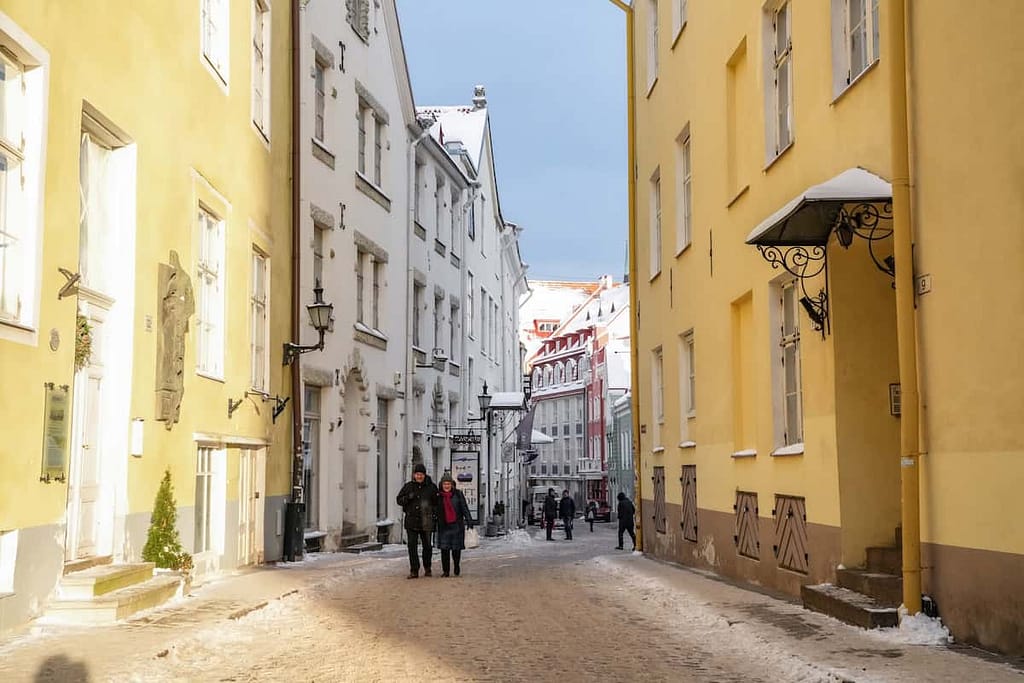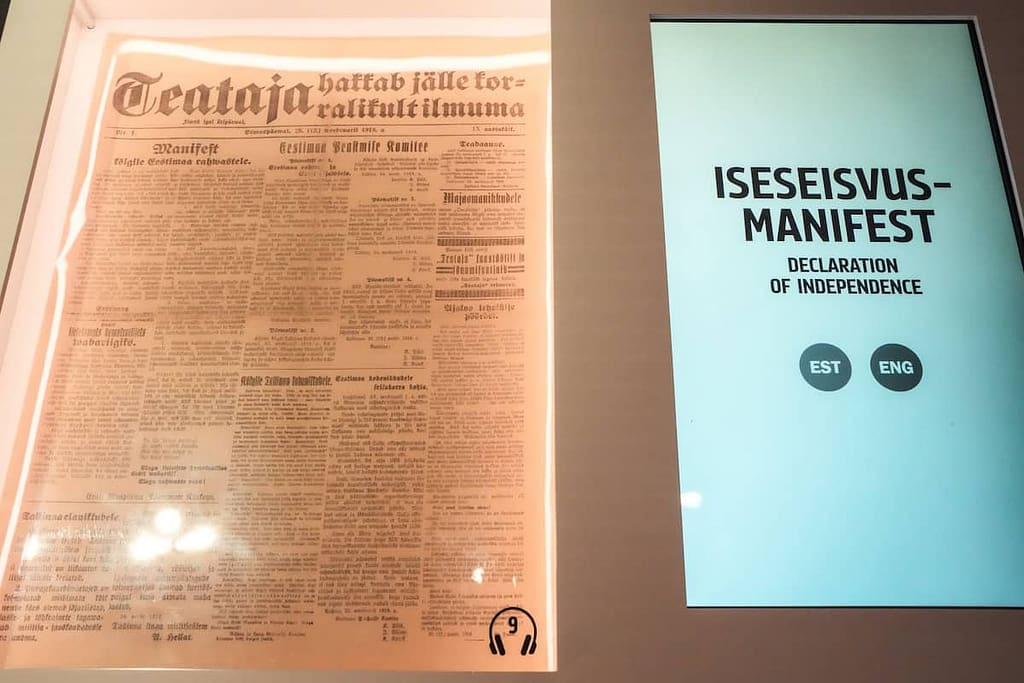Discover 17 Fascinating and Fun Facts About Estonia
I’m willing to guess most people reading this don’t know much about Estonia. Unless you’re from there. I didn’t know almost anything before I visited Tallinn in the winter – with all my winter gear in tow, of course, to avoid frostbite. Just that Tallinn had a very photogenic Christmas market. But I quickly realized there are a lot of fascinating, sometimes somber, sometimes fun facts about Estonia to learn.
If you’ve been following my blog for a while, you know I like to learn as much as I can about every city and country I visit. Anything that’s strange, intriguing, or unexpected especially piques my interest. Then I like to share some local histories and realities on the ground with my readers.
Disclaimer: Lose the Map contains affiliate links and is a member of Amazon Services LLC Associates Program. If you make a purchase through an affiliate link, I receive a small commission at no extra cost to you.
After visiting some interesting museums, taking local tours, and talking to local people in general – plus some help from Google with specific facts – I gathered the following interesting facts about Estonia.
Disclaimer: The following post contains affiliate links; if you purchase anything through these links, I get a small commission at no extra cost to you.
If you don’t want to book an Estonia trip yet, you may want to after this article.
Estonia Has the Oldest Pharmacy in the World
If you’re walking around Tallinn, be sure to visit the Town Hall Pharmacy (located, appropriately, opposite the Town Hall). Also known as Raeapteek Pharmacy, it’s been operating in this same location since it opened in 1422.
Technically, some sources will say that Florence’s Santa Maria Novella pharmacy has it beat, since it was founded almost two centuries before. But, it didn’t open to the public until the 1600s. Meaning I still count Tallinn’s Town Hall Pharmacy as the oldest. Until I write a post like this about Florence.
We’ll see.
It’s One of the Last (And Least) Christian Countries
Despite the pretty, historic churches adorning Tallinn, Estonia isn’t very hot on Christianity. Estonians were some of the last people in Europe to convert to Christianity. And apparently they aren’t all that enthusiastic about it today either. Only 16% of people say they feel religious, making it the least religious country in the world (of the countries where religion is allowed, at least).
In the 1200s, while major parts of Europe were already fighting over Catholicism vs. Orthodoxy, Estonians were just kinda…there. Up in the northeast, being pagan and minding their own business. The Crusaders swung through in the 13th century and converted the population.
But when the Soviet Union started ruling over Estonia as a result of World War II, they passed anti-religious legislation, aligned with their Communist beliefs. When Estonia gained independence, not much of that religious fervor returned, even when it did for other formerly Soviet countries.
The Grow the Most Trees Per Person in Europe
In fact, over 50% of the country is covered in forest. For a huge chunk of the year, you can’t really see the trees under the blankets of snow, but it creates a beautiful environment none the less.
Most Estonians only moved to cities one or two generations ago. They still have “country houses” they use with their families, inherited from previous generations, and often walk or even forage in the forest. And hey, who knew? Having a lot of greenery and trees, and preserving nature in general, does wonders for the atmosphere. Because…
Estonia Is The Cleanest Country in the World
If you want an escape from smog and pollution, Estonia might be one of the best places to go. It ranks in the top ten countries worldwide for air quality. The air you breathe in may be frozen, but it’s incredibly clean as well.
In fact, according to the Environmental Performance Index, Estonia is the cleanest country in the world overall, not just in terms of air pollution. This includes ecosystem vitality, water sanitation, environmental health, and many other measures.
Estonia: the country for germophobes and nature lovers.
For me personally, the shift from the low-hanging haze of Los Angeles and congested streets of Athens was a bit too much for my city-dwelling lungs to bear at first. It took a couple of hours of almost uncomfortable breathing – overwhelmed by the oxygen levels – but after a while it felt great. Maybe we were meant to breathe clean air most of the time. A controversial opinion, I know.
Estonia Celebrates Two Independence Days From the USSR
These next two are less “fun facts about Estonia” and more tragic but interesting facts about Estonia. The Soviet Union would not stop conquering Estonia. And Estonians were, to say the least, very anti-occupation every single time.
In 1917 the Russian Revolution raged and Bolsheviks overthrew the Imperial Family of Russia. Estonians, who had been clamoring for independence for a while, considering they’d never once had it in their history, took advantage of Russia’s assumed preoccupation with its own issues to agitate for, and then declare independence.
The Bolsheviks disagreed and seized power in Tallinn, later invading the rest of Estonia. The temporary governing body of the Estonian government, known by its much cooler name – Committee of Elders of the Land Council – declared independence on February 24, 1918. Britain, France, and Italy recognized the independence, pressuring the newly formed USSR to back off. So Estonia celebrates its Independence Day on February 24.
But Estonia also celebrates its Independence Day on August 20. Except they call it Restoration of Indepence Day. Because in 1939, with another World War under way, the Soviet Union and Nazi Germany signed the Molotov-Ribbentrop Pact, deciding Estonia would become Soviet. The USSR followed up this pact by annexing Estonia in 1940. Then Germany invaded from 1941 to 1944. Honestly it all became very confusing, but equally tragic and horrible for the Estonians under this harsh, murderous occupation.
As the USSR started falling apart in the 1980s, Estonians once again called for independence – in some very unique ways, as we’ll get to soon. On August 20, 1991, they successfully declared their independence from the crumbling Soviet Union once again.
They Sang Their Way to Independence
One of the many fun ways Estonians advocated for their independence? Singing. To this day, Estonia has one of the largest collections of folk songs, with over 133,000 in their repository.
The Baltic countries have always had a big tradition of choral singing as an expression of patriotism and unity. So they used it to express their desire for independence. In 1988, Five Patriotic Songs premiered at a Tartu music festival. Then, singing event after singing event took place in Tallinn, featuring mostly patriotic songs.
Then on September 11, 1988, about one third of the country – or 300,000 people – gathered for the National Song Festival in Tallinn. The Estonians’ singing was a way to both unite the locals, and protest the interminable Soviet occupation of their country.
As an added act of peaceful protest, Estonians also formed a part of the Baltic Chain along with their neighbors. On August 23, 1989, two million people from the three Baltic countries – Estonia, Latvia, Lithuania – held hands to form a 670 kilometer chain and call attention to their call for independence.
It’s the First Country to Approve Online Voting
Over 51% of the Estonian population voted online in the March 2023 Parliamentary elections. Actually, Estonia has a very digital bureaucracy in general, with over 99% of all government operations able to take place online. Remember that next time you’re at the DMV watching numbers on a screen and rethinking all your choices in life.
Online voting, known as I-voting, was first made possible in Estonia in 2005. It relies on strong voter authentication through the national digital ID system known as eID.
Public Transportation is Free in Tallinn (For Locals)
In 2013, something strange happened. Tallinn held a referendum to ask if its residents wanted to continue paying for public transport, and surprise, surprise….75% of them didn’t. So Tallinn became the first major city in the world to make public transportation free for people registered as living in the city.
The transportation system is pretty great too! Besides the fact that the Old Town is easily walkable, to go outside the old city walls, you can use buses, trams, trains, and trolley buses to get around. Well not you, you. Tallinn residents, you. You can use them as well, but you will have to pay a small fee, just like with most major transportation systems. Residents just have to validate their travel card.
Estonians Pay Taxes in Five Minutes
A moment of silence for all the Americans who just threw their laptop with Quickbooks open out the window. Including me. But yes, of all the efficient online things the Estonian government does, allowing citizens to pay taxes in a straightforward way may be one of its finest accomplishments.
The average Estonian pays taxes in five minutes. As a freelancer who regularly has meltdowns over all the different W-9s, 1099s, stubs, and expenses I have to collect come March, moving to Estonia just went from an idea that had never crossed my mind to a possible goal. You can also start businesses in five minutes. Other sources say 20 minutes, but that still sounds pretty reasonable. That may be why Estonia has one of the most favorable business climates in the world, and why…
Estonia Has More Startups With Silicon Valley (And Ten Unicorns)
For such a small country – the population hovers around 1.37 million – Estonia has a shocking number of startups, much like its entrepreneurial Finnish neighbor to the north. Estonia ranks third worldwide in number of startups per capita.
Ten of those are considered “unicorns”, meaning they are worth more than $1 billion each. You may recognize some of them: the ride-sharing platform Bolt, Transferwise for international money transfers, and gaming software company Playtech.
The number one most recognizable company in Estonia is communications giant Skype. You know a company has become successful when their name becomes a verb – to “Skype” someone.
Estonians Have the Most Books Per Household
Estonians are avid readers. They rank first worldwide for number of books per household, with an average of 218 books in every household. 35% of Estonians surveyed actually own 350 books or more.
All I’m picturing that massive palatial Beauty and the Beast library in every Estonian house. The world average is 115 books per household among people surveyed, so Estonia almost doubles that amount.
Estonia Has Five Seasons
This might be one of the weirdest facts about Estonia. Nature works differently there, appraently.
And no, the extra season is not “cold winter” and “freezing winter”. There is actually a small season between winter and spring in Estonia, a “fifth season”, that usually appears in March or April and causes strong flooding in large swathes of the country. This has to do with the bog-like landscape in large parts of the country and swelling streams discharging water very close to each other.
Here’s a sentence you never thought you’d hear: locals look forward to the floods. A lot of Estonia consists of wetlands; places like Soomaa National Park get submerged under feet of water, and residents go out in kayaks to admire the changing landscape.
The Country Has An Island of Women
The Baltic island of Kihnu is nicknamed “the Isle of Women”. Estonia has a big maritime and fishing tradition. Makes sense, being on the sea and all. Historically, many of its men worked on the seas, leaving home behind for weeks, sometimes months at a time.
On the island of Kihnu, almost all the men were fishermen. But back when most “important” jobs and tasks in a community were only allowed to be handled by men, this presented a real problem for the area when everyone was out at sea. So the women decided, “screw that noise”, and took over. They took up more and more “male” tasks over time, until they basically developed one of the first independent female-led societies.
And then realized that – surprise – “male” tasks can generally be done by women as well.
Estonia Has 2,000 Islands – One is Larger than Luxembourg
Speaking of Estonian islands – the country has over 2,000 of them. Only 22 of them have permanent residents, and they number just over 44,000 people.
Saaremaa is the biggest, larger than the entire country of Luxembourg in area. It’s known for the Kaali Meteorite Crater – which is exactly what it sounds like – some beautiful castles, and a whole lot of wildlife.
Estonians Are Smart. REALLY Smart.
I swear this wasn’t intended to be a “you should probably move to Estonia” post, yet this is what it’s turning into.
A 2018 Pisa study found that Estonian students ranked first in Europe in math, writing, and reading. The country’s literacy rate is 99.98%. You may think – isn’t every advanced economy’s literacy rate pretty much 100%? And you may be surprised to find out…no. Definitely not.
The Country Has An Interesting Sport: Wife-Carrying
To be fair, Estonia isn’t the only country that has wife-carrying as a sport. And Finland started it, based on a legend about a gang leader who initated members by making them carry heavy sacks over difficult terrains. But Estonians may be the best at it. At least, they came up with the most popular wife-carrying method.
Husbands have to race just over 250 meters in deep pools of water, sand pits, and over other obstacles to get to the finish line. The Estonian method of wife carrying involves a wife wrapping her legs around her husband’s shoulders while she holds his waist with her hands. Competitions are held in Finland every year and Estonia often dominates.
The prize? Your wife’s weight in beer. Or anyone’s wife, as long as she’s over 17 years old (you don’t actually need to be married to the woman you’re carrying).
Estonia Believes Internet Access Is A Basic Right
As a remote worker who’s dealt with crawling Internet speeds all too often – agreed. From the early days of its independence from the USSR, Estonia, a country without much in the way of valuable resources to export, decided tech was the future. (They were right).
They invested heavily in information technology, and in February 2000, the Estonian Parliament, or Riigikogu (pronounce at your own peril), passed the Telecommunications Act. It enshrines Internet access as a universal service in the country, specifically stating “Internet service which universally available to all subscribers regardless of their geographical location, at a uniform price.”
You know those peaceful forest walks we were talking about before? Well, you can still connect to YouTube on them if you’d like, as by now, the country’s Internet infrastructure is so advanced it’s available at high speeds pretty much everywhere.
What was the most surprising fact for you? If you’re Estonian, please comment and fill us all in on more unique facts about your country!

















Estonia’s blend of medieval charm, fascinating history, and unique traditions makes it an intriguing destination. Tallinn’s winter vibe and photogenic Christmas market sound like a magical experience to explore and share!
Estonia sounds fascinating! It’s amazing how much there is to discover, from its photogenic Christmas market to unique historical facts. Definitely adding it to my travel list! ❄️✨